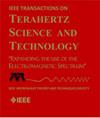Site-Specific Ray-Tracing and Experimental Validation for THz Channel Characterization
IF 3.9
2区 工程技术
Q2 ENGINEERING, ELECTRICAL & ELECTRONIC
IEEE Transactions on Terahertz Science and Technology
Pub Date : 2025-01-27
DOI:10.1109/TTHZ.2025.3534736
引用次数: 0
Abstract
Terahertz (THz) technology is seen as a key component of the upcoming 6G networks due to the huge untapped spectrum. Accurate channel models are crucial for the design and development of such THz communication and sensing systems. As the THz channel exhibits unique features including high propagation loss, sparsity, and near-field properties (with ultramassive multiple-input multiple-output systems), deterministic ray-tracing (RT), which can simulate wireless channels in a site-specific manner based on the high-frequency approximation of Maxwell's equation, is considered suitable for THz channel modeling. However, a thorough analysis of RT-based THz channel modeling and its extensive experimental validation (especially at 300 GHz) is still missing in the literature. In this article, we develop an RT modeling framework tailored for THz channels, which incorporates processes of environment reconstruction and electromagnetic calculation, material calibration, and acceleration. Then, three measurements with 14 locations ranging from 3 to 58 m covering frequency bands at 300 and 100 GHz are used to validate the developed RT framework. It is observed that there is an excellent match for the dominant paths between the real-world measurements and the RT results, and the near-field characteristics are realistically and accurately captured in the modeling. Furthermore, the validated RT framework is employed to enable an in-depth THz channel characterization at 300 GHz in an indoor hall scenario. This analysis is rooted in extensive channel data across 30 locations, consisting of experimental data at 12 locations in the first measurement and RT-simulated data for another 18 locations. The developed RT framework and the channel characterization aim to provide insights for future THz channel modeling and standardization studies.太赫兹通道表征的特定位置光线追踪和实验验证
由于巨大的未开发频谱,太赫兹(THz)技术被视为即将到来的6G网络的关键组成部分。精确的信道模型对于设计和开发这种太赫兹通信和传感系统至关重要。由于太赫兹信道具有高传播损耗、稀疏性和近场特性(具有超大规模的多输入多输出系统)等独特特征,基于麦克斯韦方程的高频近似,可以以特定地点的方式模拟无线信道的确定性射线追踪(RT)被认为适合于太赫兹信道建模。然而,文献中仍然缺少对基于rt的太赫兹信道建模及其广泛的实验验证(特别是在300 GHz)的深入分析。在本文中,我们开发了一个适合太赫兹通道的RT建模框架,该框架结合了环境重建和电磁计算,材料校准和加速过程。然后,使用3至58米范围内的14个位置的3次测量,覆盖300和100 GHz频段,用于验证开发的RT框架。观察到,实际测量结果与RT结果之间的主导路径具有很好的匹配性,并且在建模中真实准确地捕获了近场特征。此外,验证的RT框架被用于在室内大厅场景中实现300 GHz的深度太赫兹信道表征。该分析基于30个地点的广泛渠道数据,包括第一次测量中12个地点的实验数据和另外18个地点的rt模拟数据。开发的RT框架和通道表征旨在为未来太赫兹通道建模和标准化研究提供见解。
本文章由计算机程序翻译,如有差异,请以英文原文为准。
求助全文
约1分钟内获得全文
求助全文
来源期刊

IEEE Transactions on Terahertz Science and Technology
ENGINEERING, ELECTRICAL & ELECTRONIC-OPTICS
CiteScore
7.10
自引率
9.40%
发文量
102
期刊介绍:
IEEE Transactions on Terahertz Science and Technology focuses on original research on Terahertz theory, techniques, and applications as they relate to components, devices, circuits, and systems involving the generation, transmission, and detection of Terahertz waves.
 求助内容:
求助内容: 应助结果提醒方式:
应助结果提醒方式:


